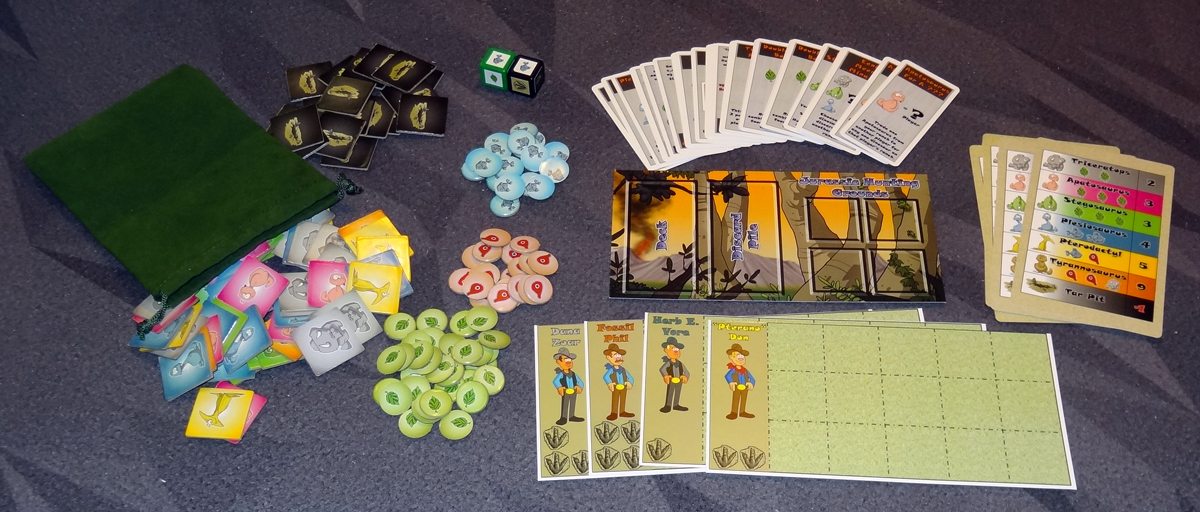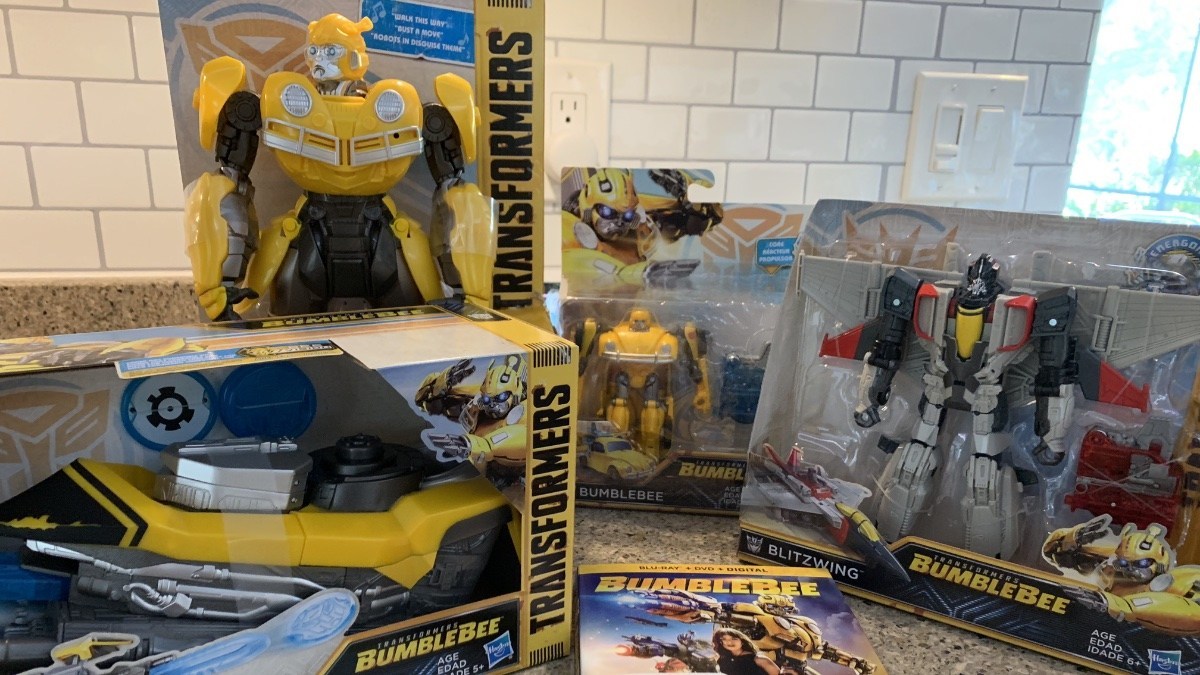So you want to run your own Jurassic Park? Here’s your chance. Run your own Dino Dude Ranch, lure impressive specimens with the right foods, and watch out for those tar pits that are opening up everywhere.
At a glance: Dino Dude Ranch is for 2 to 4 players, ages 12 and up, and takes about half an hour to play. I would say the age rating actually could be a bit lower–any player who is able to read the cards shouldn’t have too much trouble learning the rules. I played with my 11-year-old and 8-year-old. The game is currently seeking funding on Kickstarter, with a $29 pledge level (plus shipping) for a copy of the game.
New to Kickstarter? Check out our crowdfunding primer.

Components:
- 2 6-sided dice
- 52 Dinosaur tiles
- 18 Tar Pit tiles
- 44 cards
- 4 player mats
- 1 Jurassic Hunting Grounds mat
- 70 Food tokens
- 1 bag
- 6 Reference/Rancher Bonus cards
I got a demo prototype to try out, so the final game may change from what is pictured here. For instance, the dice in my copy had to be stickered, but the Kickstarter lists custom-printed dice.

The components are fairly simple: square tiles that fit onto the 3×5 grid on the player mats, and tokens that represent the different types of food. The artwork is very cartoony and suitable for a kids’ game, though it may make it harder to get your adult gamer friends to play it based on the appearance.
The Jurassic Hunting Grounds mat basically just holds the deck, discard pile, and four dinosaur tiles. It’s not really necessary, though it does remind you to have four dinosaurs available at all times.

How to Play
The object of the game is to score the most points by capturing the most valuable dinosaurs by the end of the game.
Each player gets a player mat and a reference card. The dinosaur tiles are put into the bag, and the food tokens and Tar Pit tiles are placed in a supply on the table. The Jurassic Hunting Grounds mat is placed in the center of the table, and the deck of cards is shuffled and placed on the draw area. Four dinosaurs are drawn at random from the bag and placed on the Hunting Grounds.
Gameplay is fairly simple: On each turn, you roll the two resource dice, collect the resources shown. The green die has mostly leaves, and some fish and meat. The black die has fish, leaves, a tar pit, and Draw Card. If you roll a tar pit, you have to take a Tar Pit tile and put it on your ranch. (The location of tiles on the board doesn’t matter.)

Then you perform any or all of the following actions:
- Capture up to 2 dinosaurs from the hunting grounds.
- Buy up to 2 cards.
- Play 1 card.
To capture a dinosaur, you must feed it the foods that it likes, which are listed on the reference card. For instance, a Triceratops needs two leaves, while a T. Rex needs two meat and a Triceratops.

You can buy cards by trading in any two food tokens. Some cards can be played out of turn–you may play up to one “Out of Turn” card on each other player’s turn. The cards are pretty straightforward–some provide bonuses for you, harm other players, or cancel a card played.
The game ends when either all of the dinosaur tiles have been captured, or when any player fills up all 15 spaces on their board. Players add up the values of the dinosaurs (as listed on the reference cards) and subtract 1 point for each Tar Pit. Then each player also gets a Rancher Bonus, shown on the backs of the reference cards. For instance, you might get 3 extra points for each Pterodactyl-Plesiosaurus pair you have on your ranch, or score points for Tar Pits instead of losing them. Highest score wins; ties go to the player with fewer Tar Pits.

There are a few variant rules, allowing for team play, a slightly longer game, or attacking people with Tar Pits instead of putting them on your own ranch, but that’s the basic idea.
The Verdict
I played Dino Dude Ranch with my kids and they had a fun time. Even though there isn’t any gameplay effect for having things in any particular space on the board, they liked arranging their dinosaurs on the board, shifting them around like they were wandering around the fields. They even made up some variant rules of their own on a second play, throwing dinosaurs into tar pits to “fill up” the tar pits and remove them from the board.
Dino Dude Ranch does have a pretty high luck factor: you get some number of resources each turn based on a die roll and you don’t really have much control over Tar Pits. However, you do get some choices in how you spend the resources: you can capture a dinosaur as soon as you can afford it, or you can save up for a more valuable dinosaur later. You can also buy cards–and these can be fairly powerful, awarding you more resources or even dinosaurs sometimes.
The game plays very quickly and is easy to learn, and both of my kids really got into collecting dinosaurs and trying to capture anything they thought the other player was going for. The T. Rex is especially fun–there are only three of them in the whole game, and you want to be sure that you have some meat and a Triceratops when it shows up, because it’s worth a lot of points.
The Rancher bonus means that you aren’t all going for exactly the same thing, but I wasn’t sure if the scoring values were really all that balanced. For instance, in one play I had the card that gives 1 point for Tar Pits instead of subtracting points for them, but I only ended up getting one Tar Pit the entire game. There wasn’t really a good way to collect more of them.
Dino Dude Ranch is a fairly light game, best suited for casual gamers and younger players. Those who want more strategic options or more control over their own gaming fate probably won’t enjoy it as much. For you paleontologists, the rulebook does include a section on fun facts on each dinosaur, so before you go complaining that the dinosaurs are from different periods or geographical areas, that’s listed in the back. But, hey, it’s a game about people with dinosaur ranches–it’s not going to be scientifically accurate no matter how you slice it.
Overall, I think Dino Dude Ranch can be fun for the kids but may be a little light for my regular gaming group. It plays pretty quickly, though, so it could also make for a filler game between heavier titles.
For more information or to pledge for a copy, visit the Dino Dude Ranch Kickstarter page.




